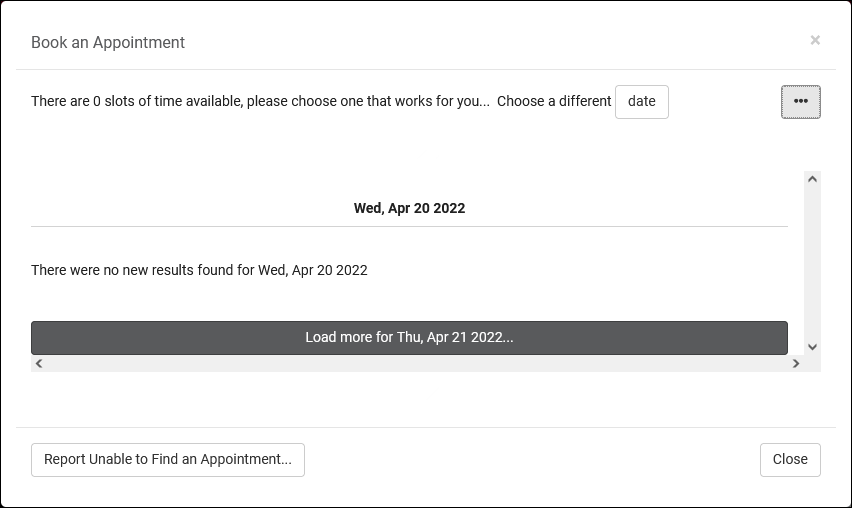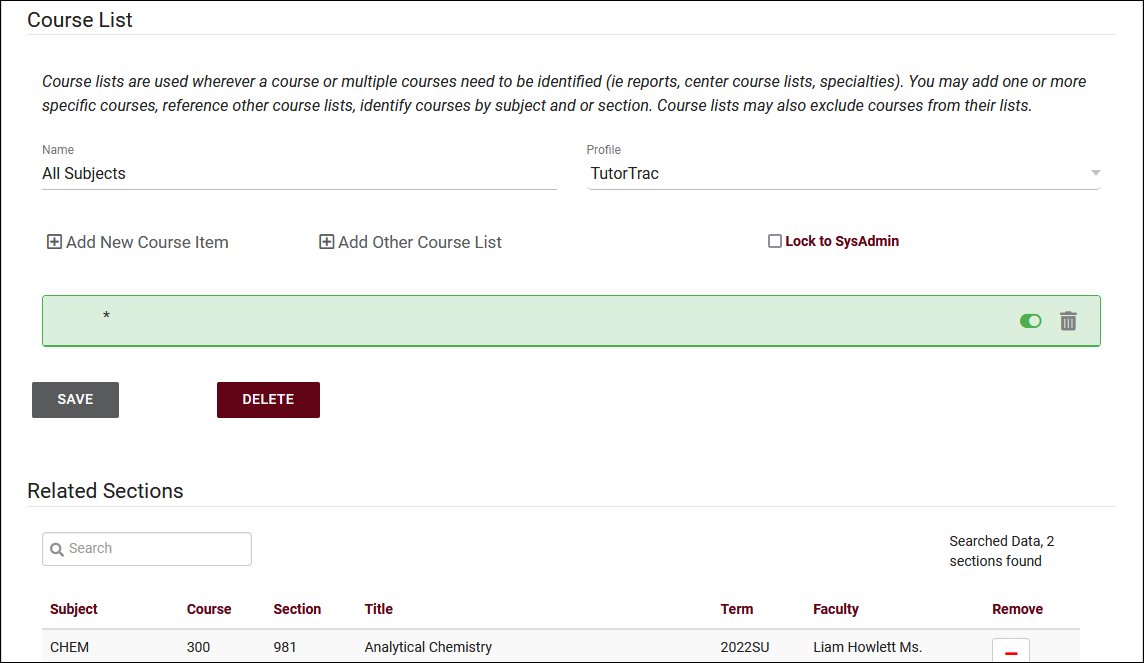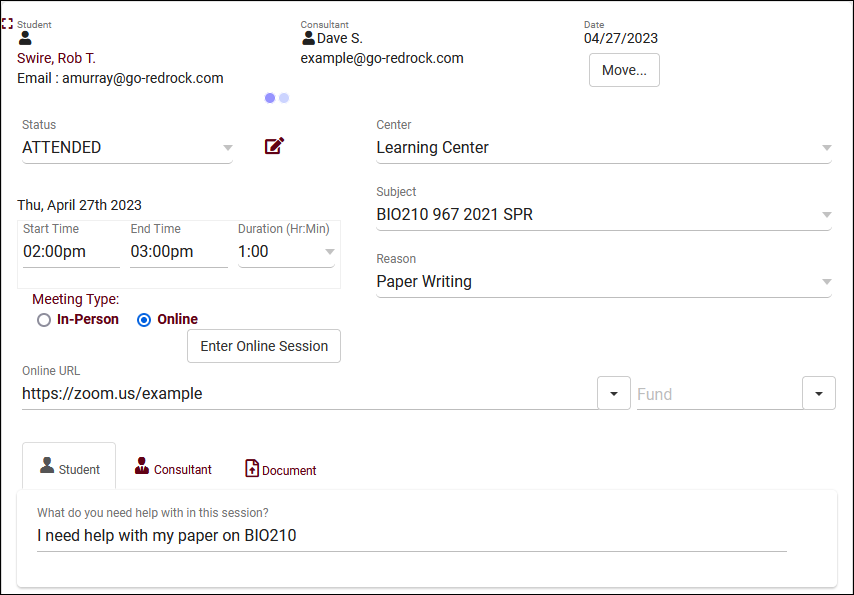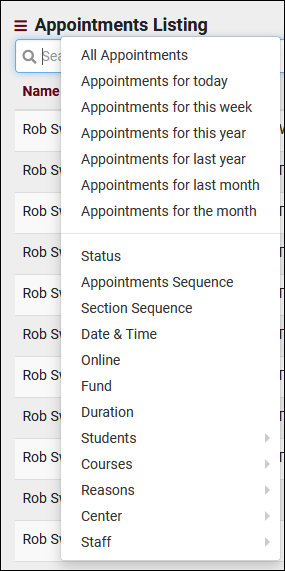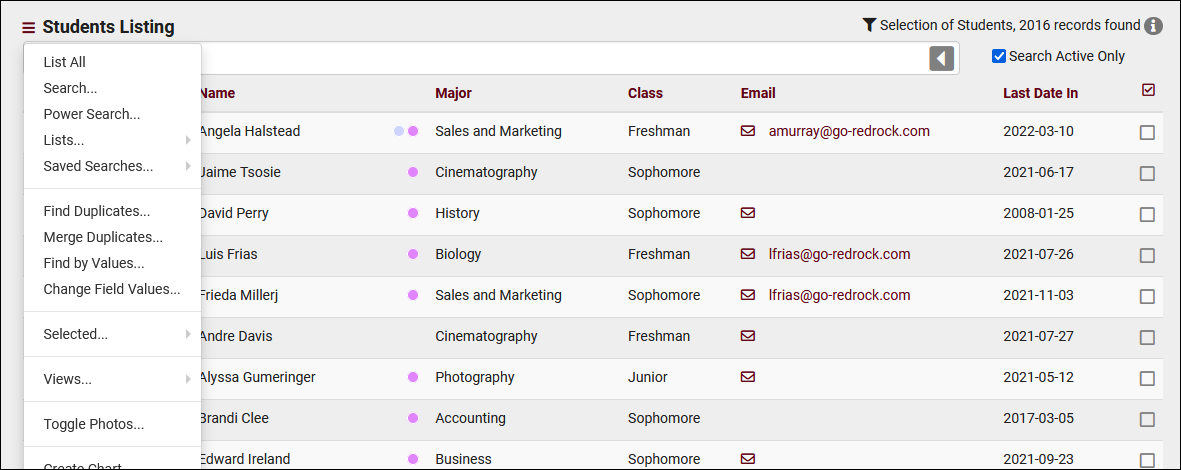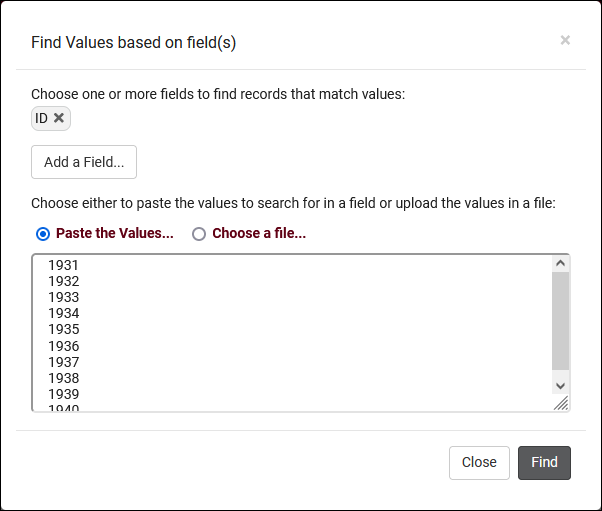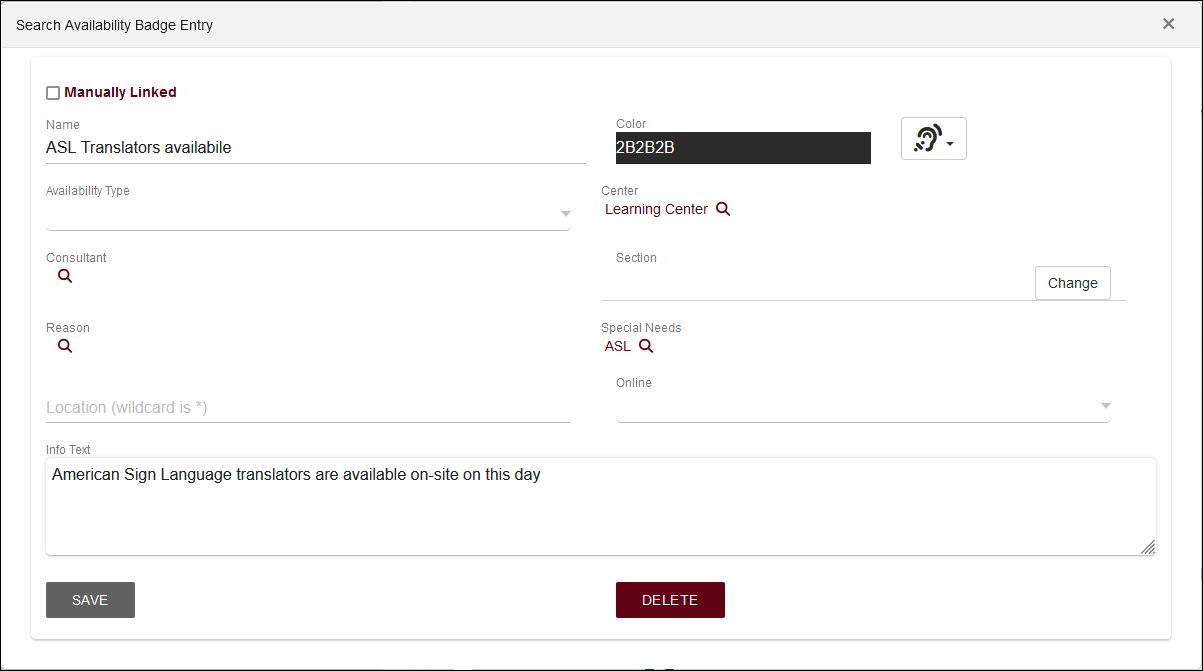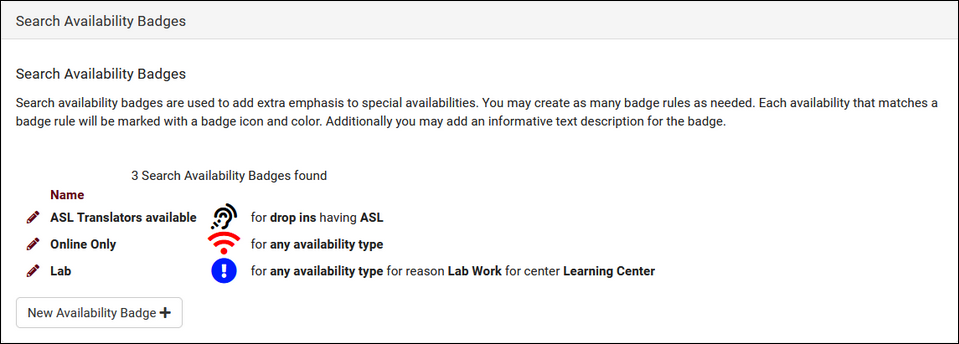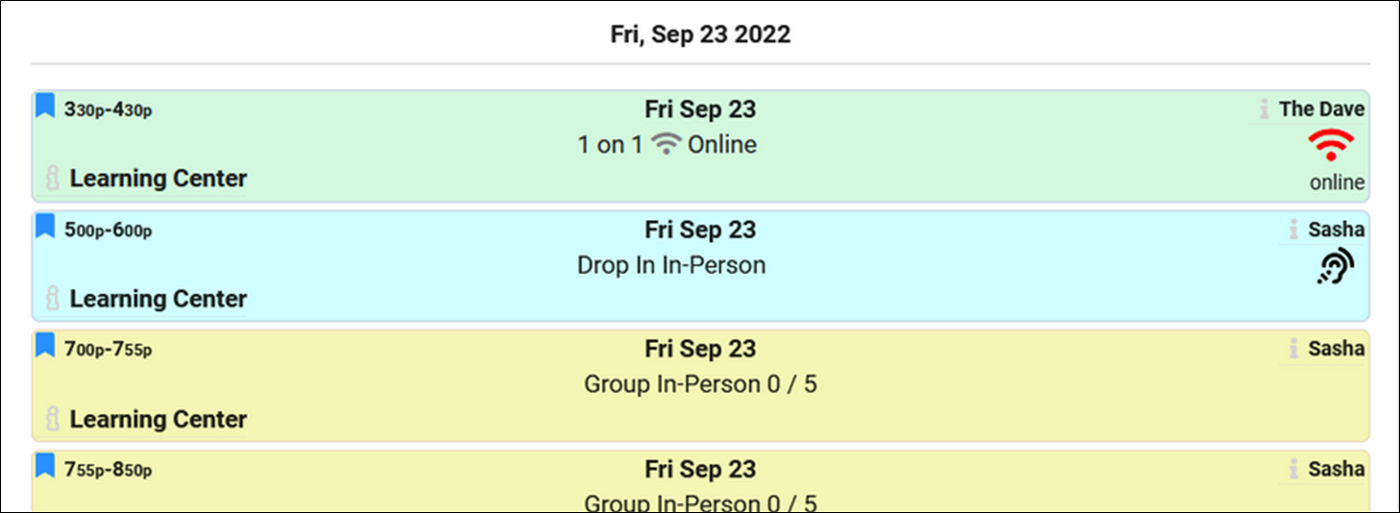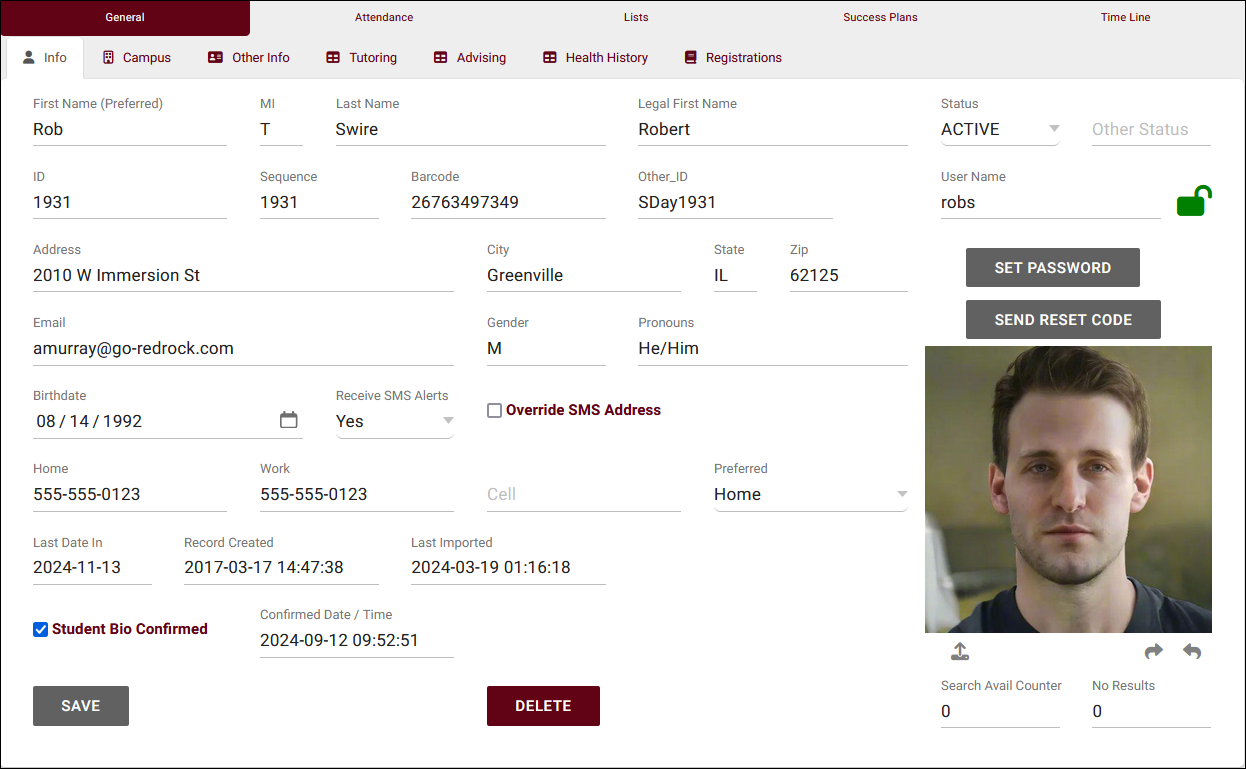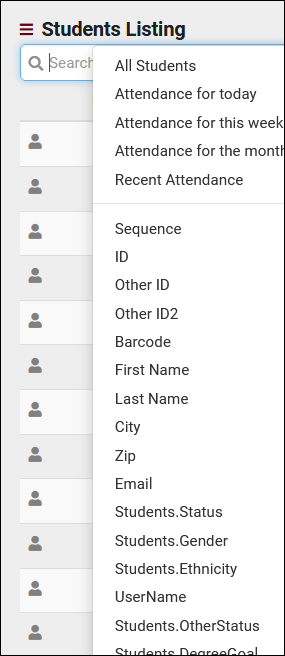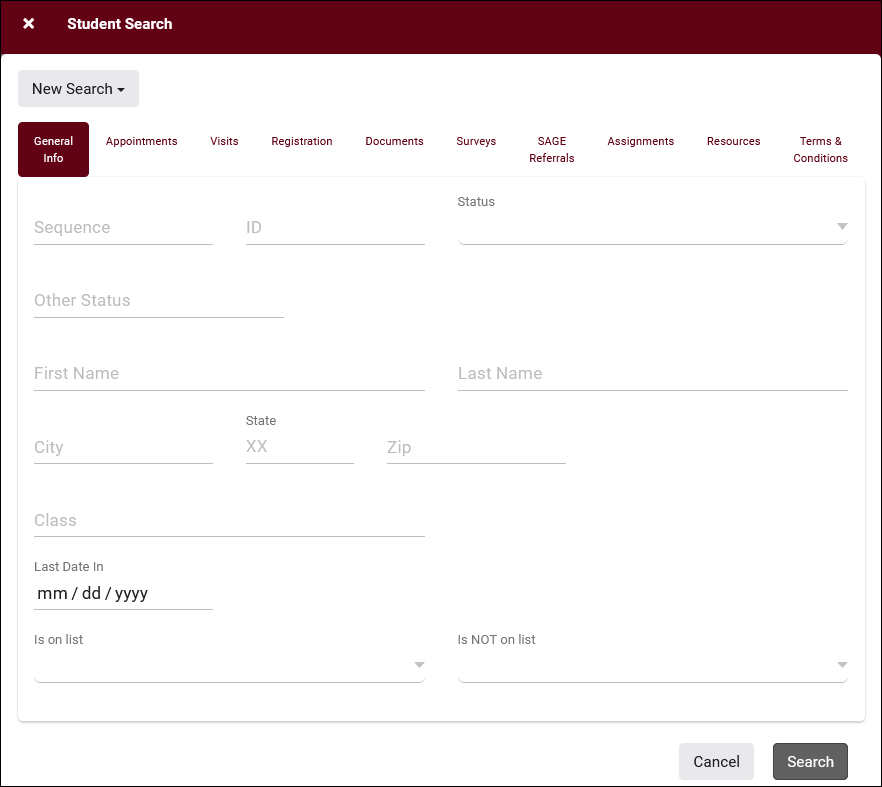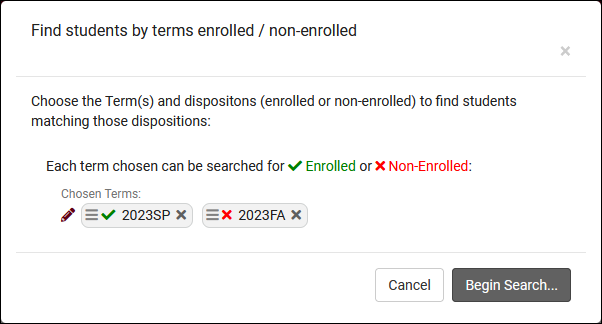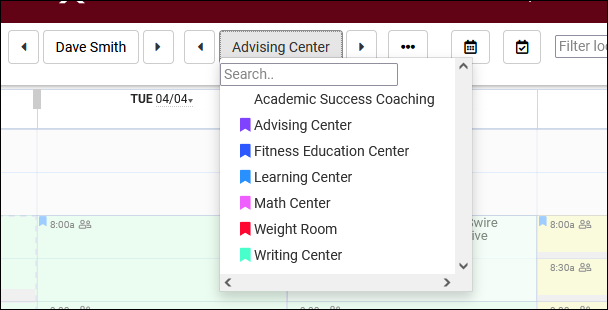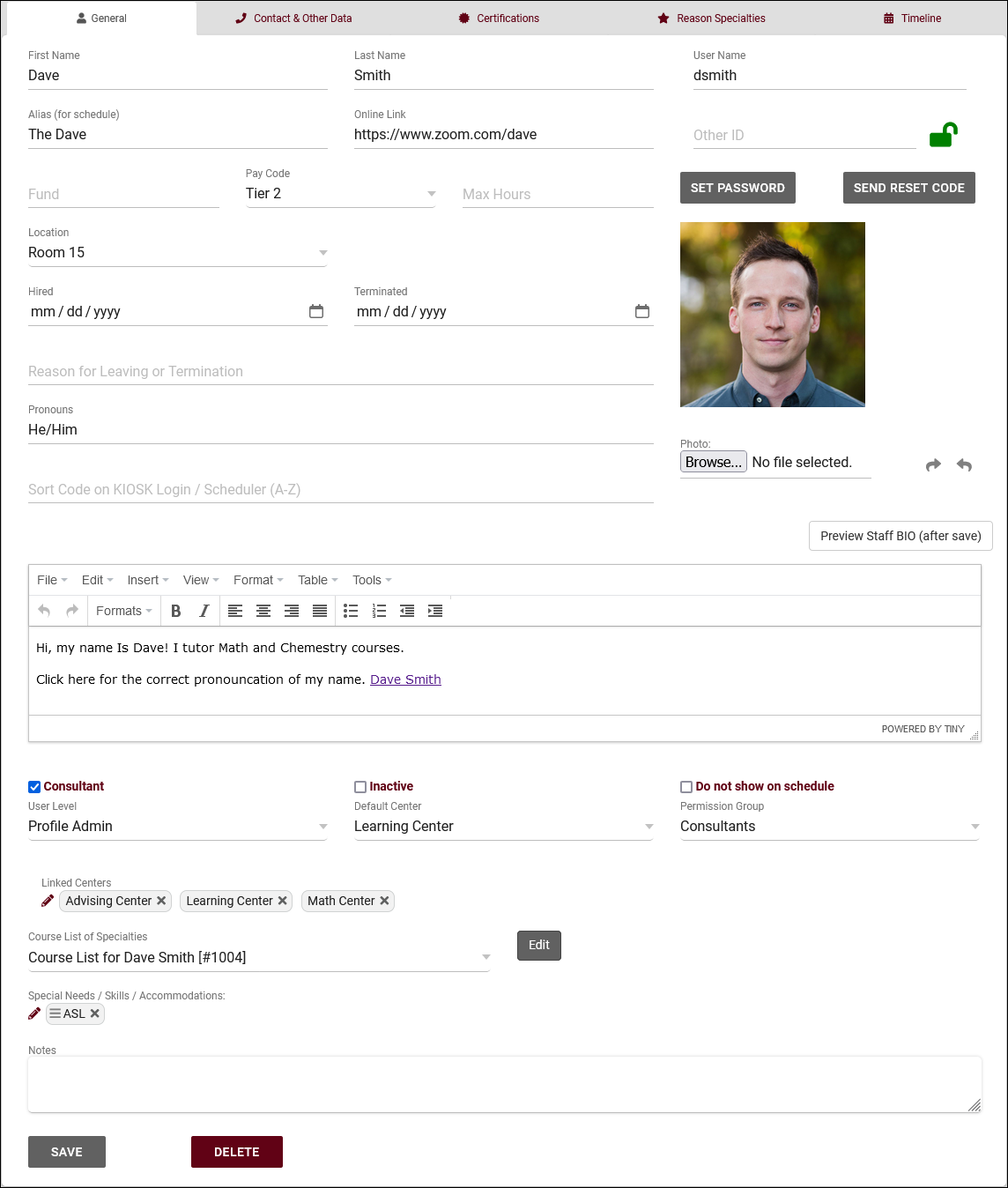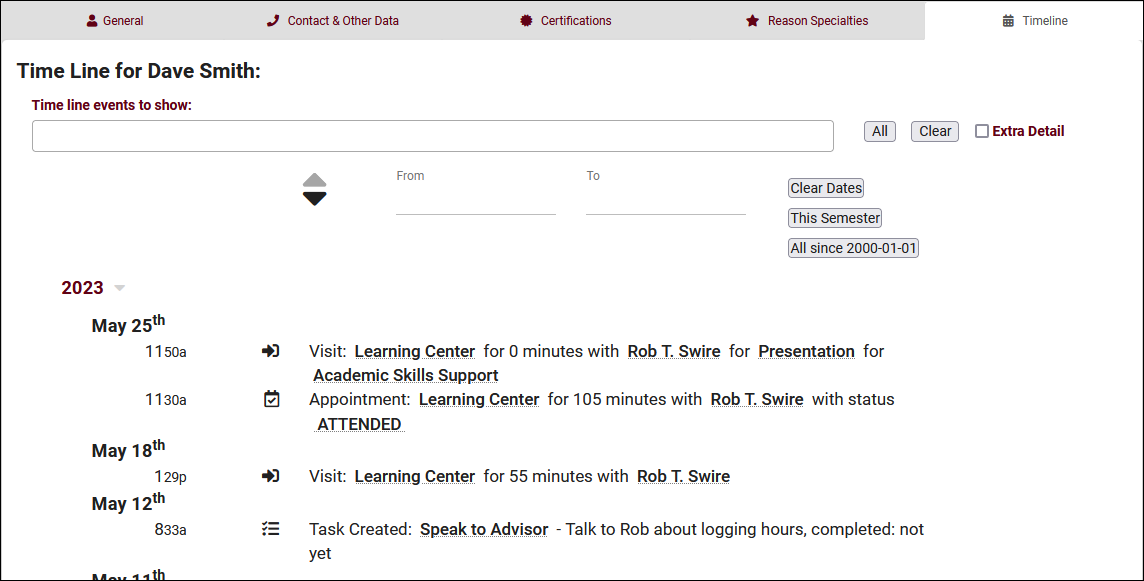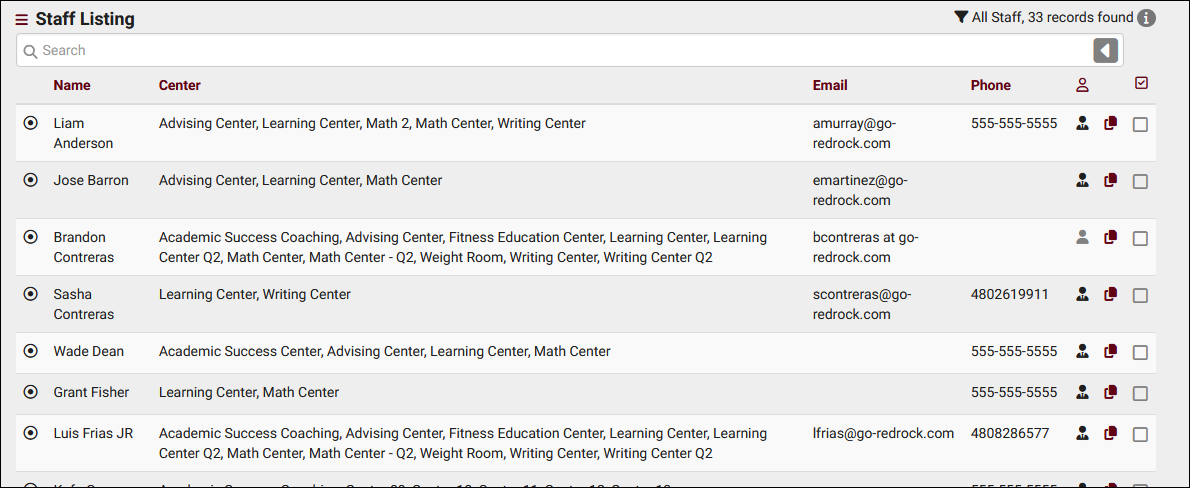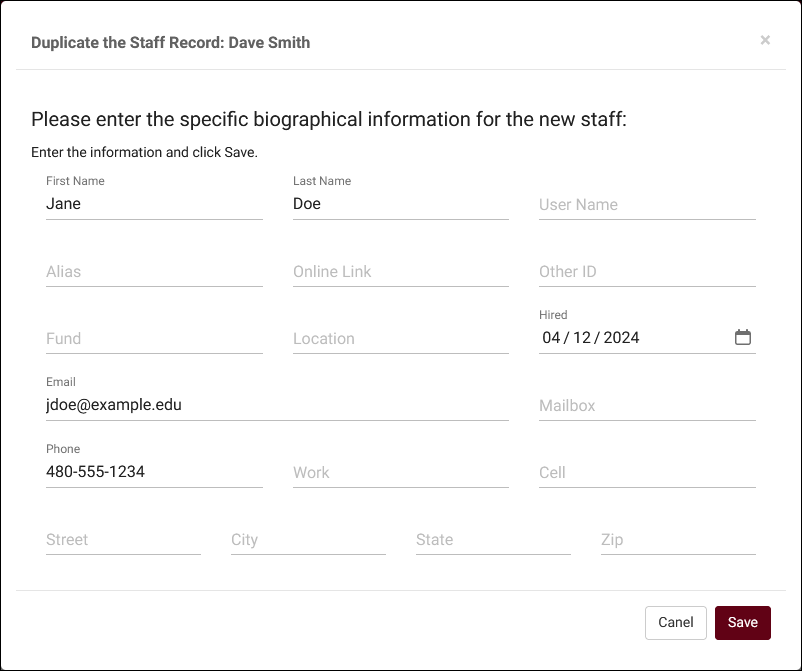TracCloudWhatsNew
From Redrock Wiki
This page highlights some of the recent changes made to the TracCloud platform, and how you can utilize them on your own instance. A list of past changes and a full changelog can be found in the tabs above.
If you have any questions about these changes, feel free to reach out to us on our helpdesk.
If you've created a new availability for one of your Consultants and it's not showing up as expected when performing a search for appointment times, there are a few possible causes. This portion of the wiki outlines these possibilities, ordered from most to least likely based on what we at Redrock have experienced working with campuses directly.
1. Center and Consultant Course Lists
The most common cause when an availability isn't appearing in search results is misconfigured Course Lists. Both your Consultant and your Center need to be assigned to the subject you're searching for (unless your Center or Reason is set to ignore Consultant Specialties). Make sure you Process Specialties (Step 2) after applying any changes.
Consultant Course List: Other > Listings > Staff > [Your Staff] > Course List of Specialties
Center Course List: Other > Other Options > Profiles > [Your Profile] > Centers > Course List for this Center
A complete list of Course Lists can also be found by simply going to: Other > Listings > Course Lists
2. Process Specialties
This is always recommended after applying changes to Course Lists, but it may also be the case that the specific section you searched for was imported after you created the Course List for your Center/Consultant, and a Course List refresh alone may resolve this issue. We can setup an automated process to Process Specialties daily if this occurs often, reach out to us using the 'Support' tab above for more information.
3. Reason Assignments
Similar to ensuring that your courses are assigned to the correct Consultant and Center, the same applies for Reasons. This step only applies if you're using Reason as a search criteria.
For Consultants, go to Other > Listings > Staff > [Your Staff] > Reason Specialties
For Centers, go to Other > Other Options > Profiles > [Your Profile] > Centers > [Your Center] > Active Reasons
4. Availability Subject/Reason
If your availability is assigned to the wrong subject or reason, this can cause it to be unintentionally filtered out of results. Make sure the value entered here is correct, especially if you're using wildcards. If these are blank (i.e., available for all specialties), you can skip this troubleshooting step.
Schedule > [Consultant] > Availability
5. Profile Time Restrictions
If your availability is 60 minutes long, but your profile only allows for a maximum of 50-minute appointments, this can unexpectedly filter out availabilities if you haven't updated your profile preferences to match this new limit. The relevant options to check here are Schedule no sooner than and no later than, ensure that you're searching within an allowed range. As well as Minimum and Maximum Appointment Duration, make sure your availability is within the limits defined by your profile.
Other > Other Options > Profiles > [Your Profile] > Prefs > Scheduling > Time Restrictions
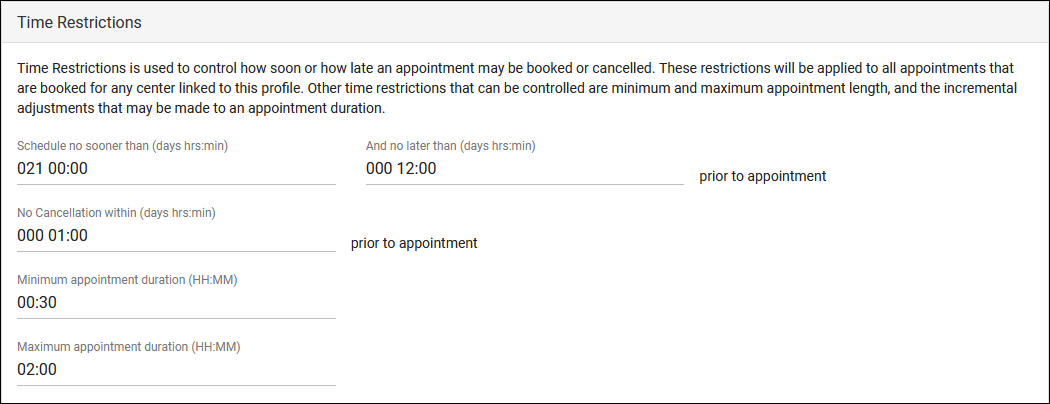
More Scheduling Prefs Information
6. Reason/Subject Required for Search
In the event that you aren't searching for both Reason and Subject, and the previous steps haven't resolved your issue, it's worth double-checking to make sure your Profile hasn't been mistakenly set to require a Subject/Reason to show availabilities. Make sure the highlighted settings match the search you're performing on the dashboard.
Other > Other Options > Profiles > [Your Profile] > Prefs > Scheduling > Special Fields

More Scheduling Prefs Information
7. Skills and Accommodations
If your campus utilizes the Skills/Accommodations feature, with 'Excluded when not chosen' enabled, make sure your consultant/availability is assigned to that Skill/Accommodation.
Consultants: Other > Listings > Staff > [Staff Account] > Special Needs/Skills/Accommodations
Availabilities: Schedule > [Availability] > Special Needs > Special Needs/Skills/Accommodations
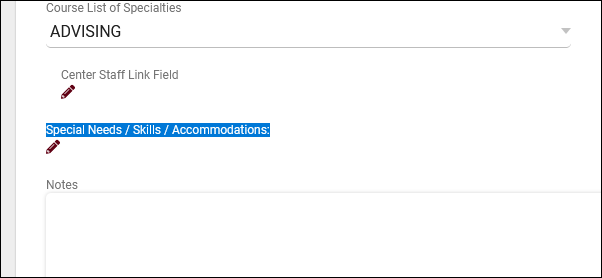
2023-04-25 | Catching up on the past few weeks of updates
You may have noticed a delay since the last "What's New" article, but that's not because new features haven't been getting added, it's the exact opposite in fact! We're working on updating a large portion of the TracCloud wiki to reflect the new options and capabilities of the system, as well as to provide more in-depth guides where needed. That's still in progress, but this article is to catch up on some of the features that we haven't had the chance to highlight yet. (Asynchronous availabilities are coming soon as well!)
- 2023-04-18: "Consultant" is now an editable field in the Students Visits Cleanup Data report.
- 2023-04-14: "Send Link via Email" on Student Confirm Bio settings now shows a QR code for the student to quickly scan on the kiosk
- 2023-04-12: New report, Student Search Availabilities
- View information about what subjects and reasons students are searching for, and whether or not they booked an appointment. More information.
- View information about what subjects and reasons students are searching for, and whether or not they booked an appointment. More information.
- 2023-04-07: An "Advanced Prefs" menu has been added in Profile Prefs to better separate some of the less used and not typically recommended options.
- 2023-04-06: You can now search the student listing based on whether or not students have confirmed their bio
- Use "Students.CustomData/BIOConfirmed=1" to find students who have confirmed their bio, and "Students.CustomData/BIOConfirmed=#1" to find students who haven't.
- Use "Students.CustomData/BIOConfirmed=1" to find students who have confirmed their bio, and "Students.CustomData/BIOConfirmed=#1" to find students who haven't.
- 2023-04-06: "Visit" steps in Success Plans can now be configured with a minimum duration.
- 2023-04-06: Student birthdate has been added as a field to select in Student Confirm Bio.
- 2023-04-06: Faculty email address added as an available field to the Visits by ?? and Visits by Faculty and Subject Reports.
- 2023-04-02: New Referrals Listing menu.
- A new listing menu has been added for SAGE referrals. This can be added to your permission group by going to Other > Other Options > Groups > [The group you want to modify] > Admin/Modules > Table Access, then add Referrals to that list and save.
- A new listing menu has been added for SAGE referrals. This can be added to your permission group by going to Other > Other Options > Groups > [The group you want to modify] > Admin/Modules > Table Access, then add Referrals to that list and save.
- 2023-03-24: Custom views have been added to the Appointments Listing
- 2023-03-24: New report, Consultant Max Hours and Non-Duplicated Appointment Time
- Review how many non-duplicated hours your consultants were booked for, along with their max hours (if applicable).
- Review how many non-duplicated hours your consultants were booked for, along with their max hours (if applicable).
- 2023-03-21: Date range searches in Visits/Appointments SFTP Export
- In the Number of Days to Export field, you can now enter a value such as "14...5" to export the last 14 days of data up to the last 5 days. Some campuses may require more time to clean up recent records before including them in the export, which was the purpose of this addition.
- In the Number of Days to Export field, you can now enter a value such as "14...5" to export the last 14 days of data up to the last 5 days. Some campuses may require more time to clean up recent records before including them in the export, which was the purpose of this addition.
- 2023-03-21: "Remember Student" option in Batch Entry
- Depending on when you're reading this, the wiki link above might not have an updated screenshot, but you'll see the new "Remember Student" option right next to "Remember Notes" on the Batch Entry tab. This allows you to repeatedly create visits for the same student account. E.g., a generic student account for prospective students.
- Depending on when you're reading this, the wiki link above might not have an updated screenshot, but you'll see the new "Remember Student" option right next to "Remember Notes" on the Batch Entry tab. This allows you to repeatedly create visits for the same student account. E.g., a generic student account for prospective students.
- 2023-03-21: SAML Duel Tenant Support
- If your campus requires this, reach out to our helpdesk using the support links at the top of your screen and we'd be happy to help you set it up.
If you've created a new availability for one of your Consultants and it's not showing up as expected when performing a search for appointment times, there are a few possible causes. This portion of the wiki outlines these possibilities, ordered from most to least likely based on what we at Redrock have experienced working with campuses directly.
1. Center and Consultant Course Lists
The most common cause when an availability isn't appearing in search results is misconfigured Course Lists. Both your Consultant and your Center need to be assigned to the subject you're searching for (unless your Center or Reason is set to ignore Consultant Specialties). Make sure you Process Specialties (Step 2) after applying any changes.
Consultant Course List: Other > Listings > Staff > [Your Staff] > Course List of Specialties
Center Course List: Other > Other Options > Profiles > [Your Profile] > Centers > Course List for this Center
A complete list of Course Lists can also be found by simply going to: Other > Listings > Course Lists
2. Process Specialties
This is always recommended after applying changes to Course Lists, but it may also be the case that the specific section you searched for was imported after you created the Course List for your Center/Consultant, and a Course List refresh alone may resolve this issue. We can setup an automated process to Process Specialties daily if this occurs often, reach out to us using the 'Support' tab above for more information.
3. Reason Assignments
Similar to ensuring that your courses are assigned to the correct Consultant and Center, the same applies for Reasons. This step only applies if you're using Reason as a search criteria.
For Consultants, go to Other > Listings > Staff > [Your Staff] > Reason Specialties
For Centers, go to Other > Other Options > Profiles > [Your Profile] > Centers > [Your Center] > Active Reasons
4. Availability Subject/Reason
If your availability is assigned to the wrong subject or reason, this can cause it to be unintentionally filtered out of results. Make sure the value entered here is correct, especially if you're using wildcards. If these are blank (i.e., available for all specialties), you can skip this troubleshooting step.
Schedule > [Consultant] > Availability
5. Profile Time Restrictions
If your availability is 60 minutes long, but your profile only allows for a maximum of 50-minute appointments, this can unexpectedly filter out availabilities if you haven't updated your profile preferences to match this new limit. The relevant options to check here are Schedule no sooner than and no later than, ensure that you're searching within an allowed range. As well as Minimum and Maximum Appointment Duration, make sure your availability is within the limits defined by your profile.
Other > Other Options > Profiles > [Your Profile] > Prefs > Scheduling > Time Restrictions

More Scheduling Prefs Information
6. Reason/Subject Required for Search
In the event that you aren't searching for both Reason and Subject, and the previous steps haven't resolved your issue, it's worth double-checking to make sure your Profile hasn't been mistakenly set to require a Subject/Reason to show availabilities. Make sure the highlighted settings match the search you're performing on the dashboard.
Other > Other Options > Profiles > [Your Profile] > Prefs > Scheduling > Special Fields

More Scheduling Prefs Information
7. Skills and Accommodations
If your campus utilizes the Skills/Accommodations feature, with 'Excluded when not chosen' enabled, make sure your consultant/availability is assigned to that Skill/Accommodation.
Consultants: Other > Listings > Staff > [Staff Account] > Special Needs/Skills/Accommodations
Availabilities: Schedule > [Availability] > Special Needs > Special Needs/Skills/Accommodations

2023-03-14 | Notification Menu Improvements
The Notification menu has received an update to make it easier to search, categorize, and hide notifications. The drop-down option at the top of the menu allows you to select the category of notification that you want to filter by (Task, Appointment Request, etc). Additionally, each notification can now be hidden with the eye icon (or you can hide all shown with the button at the bottom). Hidden notifications can be viewed by clicking on the There are X hidden items text.
An Appointment represents the reservation of a time slot (availability) between a student and a consultant. The student intends to show up at your center at X date & time, for Y subject, Z reason, etc. If the student attends this appointment, a visit record will be created. If they do not attend, no visit will be created, and the status will be recorded as cancelled or missed as needed. Appointments can additionally contain custom fields that both students and staff can fill out, as well as documents that need to be shared between the two parties.
The Appointments Listing can be viewed by going to Other > Listings > Appointments. Access to this listing can be provided by adding "Appointments" table access to a permission group under 'Admin / Modules'. This listing contains all appointment records that you have permission to view, including the ability to make batch changes, create custom views, or simply search for and few individual appointments. The icon shows if the registration that the appointment was booked for is still active.
Each column of information displayed has a clickable header that will sort the listing accordingly. Clicking once sorts ascending, a second click will sort descending.
Using the Search Bar on this screen, we can easily perform quick searches to find specific appointment records. Right clicking in the search bar (shown below) will provide a list of available appointment fields to search, click any of these to auto-fill the search bar.
Example Searches:
- Find an appointment by a single value, such as student ID. Specifying 'Students.ID=' actually isn't required for ID or Name searches, but it works well as an example.
- Students.ID=1931
- Students.ID=1931
- Search multiple fields at once, separate your searches by a space.
- Students.ID=1931 Appointments.Online=1
- Students.ID=1931 Appointments.Online=1
- When performing multiple searches where at least one field contains a space, make sure to surround the contents you're searching for with quotation marks.
- Students.ID=1931 Reasons.Reason="Paper Writing"
- Students.ID=1931 Reasons.Reason="Paper Writing"
- Date searches such as this are required to be formatted as YYYY-MM-DD
- Appointments.StartDT=2023-04-27
- Appointments.StartDT=2023-04-27
- You can also search by a date range with ... (quote protected)
- Appointments.StartDT="2023-04-20...2023-04-30"
- Appointments.StartDT="2023-04-20...2023-04-30"
Hamburger Menu
Every listing page in the Trac System features a hamburger menu with utilities to search for or interact with your list of records. Some of these options are specific to a certain listing/record-type, others are shared. The following list includes definitions for the hamburger menu options available on this listing, and how they can be utilized.
- All Appointments, Today, Recent Appointments, etc
- These options allow you to quickly search for a specific date range for your appointment records. Recent Appointments is the default, showing the past 6 months of data.
- These options allow you to quickly search for a specific date range for your appointment records. Recent Appointments is the default, showing the past 6 months of data.
- Search
- This utility will open a pop-up window unique to each Listing it's present on, allowing you to search your records by a number of different fields.
- This utility will open a pop-up window unique to each Listing it's present on, allowing you to search your records by a number of different fields.
- Power Search
- This option provides a simple but powerful search utility to find the records you need. String together multiple searches, adding or removing results for each. Use Search Symbols to include ranges of data, and Save Searches for later use if needed. The search term 'blankornull' can be used to find all records with a value of nothing ("") or null ().
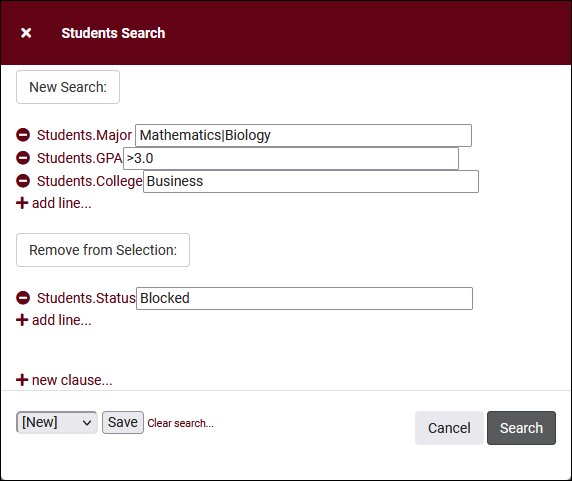
- Saved Searches
- See Saved Searches for more information.
- See Saved Searches for more information.
- Show these <records>
- This utility takes your selection of records, finds the related records, and takes you to that listing with the resulting records. For example, on the Registration listing, you can "Show these Students" to display the student records for the registrations that you were viewing.
- This utility takes your selection of records, finds the related records, and takes you to that listing with the resulting records. For example, on the Registration listing, you can "Show these Students" to display the student records for the registrations that you were viewing.
- Find/Merge Duplicates
- These utilities can be used to cleanup duplicate records in your Trac System. We highly recommend reaching out to Redrock Support directly for assistance in cleaning up this data.
- These utilities can be used to cleanup duplicate records in your Trac System. We highly recommend reaching out to Redrock Support directly for assistance in cleaning up this data.
- Find by Values
- Change Field Values
- This utility allows you to make modifications in to your records in bulk. Similar to the Merge Duplicates utility, we highly recommend coordinating with Redrock Support directly on this setting.
- This utility allows you to make modifications in to your records in bulk. Similar to the Merge Duplicates utility, we highly recommend coordinating with Redrock Support directly on this setting.
- Selected...
- The Selection Tool offers several options to filter and manage your records. More information on this feature can be found in its own dedicated article here.
- The Selection Tool offers several options to filter and manage your records. More information on this feature can be found in its own dedicated article here.
- Views
- See Views for more information.
- See Views for more information.
- Create Chart
- Based on the data currently being viewed a chart can be generated to visually illustrate the relationships in the data.
- Based on the data currently being viewed a chart can be generated to visually illustrate the relationships in the data.
- Allows you to print the contents of the current listing, by extension this also allows you to export the current list as a PDF file.
- Allows you to print the contents of the current listing, by extension this also allows you to export the current list as a PDF file.
See Also
- Custom Fields - Custom fields can be placed in appointment records.
Search Availability badges can be used to add information and indicators to availability slots. Each badge can appear for certain conditions, based on center, availability section/reason, location, skills/accommodations, etc.
Click "New Availability Badge" to begin. This will open a form where you can enter the details for your badge.
Manually Linked
Name
- Name of the Badge. This will not be displayed for students
- Name of the Badge. This will not be displayed for students
Availability Type
- Drop In, 1-on-1, or Group availability
- Drop In, 1-on-1, or Group availability
Consultant
- Assign a specific Staff
- Assign a specific Staff
Reason
- Assign a specific Reason
- Assign a specific Reason
Center
- Assign a specific Center
- Assign a specific Center
Section
- Assign a specific Subject
- Assign a specific Subject
Special Needs
- Select if applicable (more information)
- Select if applicable (more information)
Online
- Availability Type; In Person, Online, Online Optional, or Phone
- Availability Type; In Person, Online, Online Optional, or Phone
Location
- Location of the availability
- Location of the availability
Once you've decided where the badge is needed and have made your selections from the options above, you can now determine which icon, colors, and info work best for the badge created.
Color:
- Choose your preferred color for the badge. Consider contrast when setting this color, availability backgrounds are as follows.
- 1-on-1: #d3f8deGroup: #F5F5B4Drop-in: #d0ffffAsync: #d8c7ff
Icon:
- Choose from the list of available icons or alternatively click the button to use a custom icon from Font Awesome. In that case, you would copy the class values from the icon you want to use.
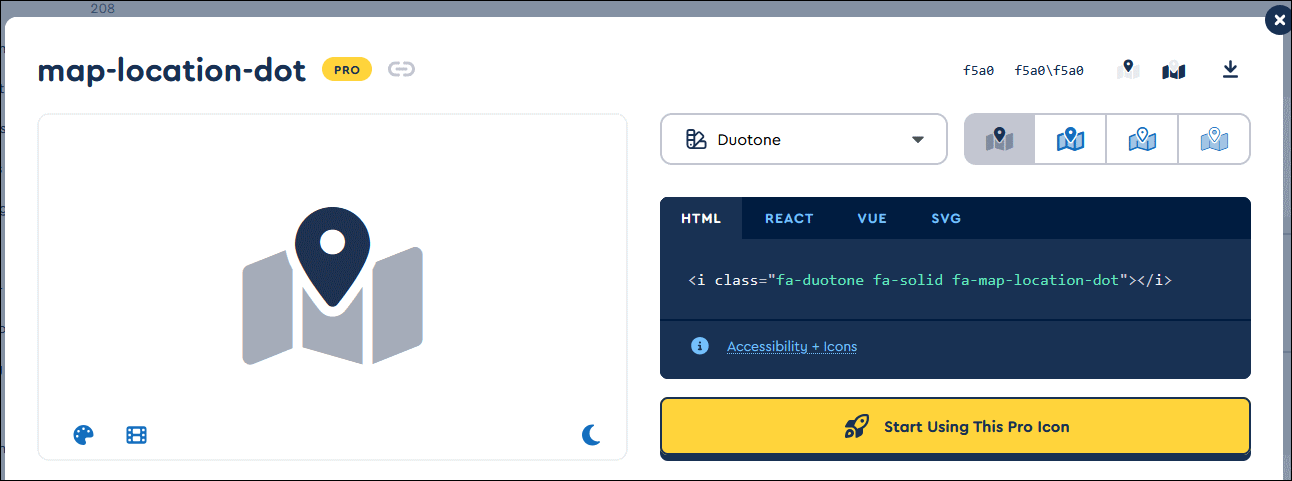
- Paste them into TracCloud.

- Then click 'OK.'

Info Text:
- Enter text that will display when students & staff hover over the icon
- Enter text that will display when students & staff hover over the icon
In the example screenshot above, this badge will only appear on availabilities of staff who have been assigned the “ASL” accommodation and are available in the Learning Center. Once saved, your badge will appear in the profile preferences if you need to edit/delete it later.
Any fields left blank will not be considered for where this badge appears, you can be as specific or non-specific as needed. You can also create as many badges as you'd like, more than 1 tag can appear for the same availability. When students search for an availability, the badges will display to the right of the screen as shown below.
Student data is one of the most important parts of your Trac System, on top of being the record that all their visits, appointments, documents, and more are assigned to, you also have the student's information directly. You can run reports on visits grouped by student majors, or send emails to students of a certain class, cohort, or any other field you have available. This article goes over some of the ways you can search for these records.
The Students Listing itself (found by clicking 'Students' in the Navigation Bar) contains all student records uploaded to your Trac System. From this page, we're able to manage student data in bulk, creating lists, sending emails, or submitting SAGE referrals, or we can open a specific student record and manage just one student profile at a time.
Each column of information displayed has a clickable header that will sort the listing accordingly. Clicking once sorts ascending, a second click will sort descending.
Using the Search Bar on this screen, we can easily perform quick searches to find specific students. Right clicking in the search bar (shown below) will provide a list of available student fields to search, click any of these to auto-fill the search bar.
Example Searches:
- Find a student by a single value, such as ID. Specifying 'Students.ID=' actually isn't required for ID or Name searches, but it works well as an example.
- Students.ID=1931
- Students.ID=1931
- ...or name. Names should be formatted as 'Last, First' or 'First M Last'. 'First Last' will also work if middle names are not being imported.
- Day, Rob
- Day, Rob
- Search multiple fields at once, separate your searches by a space.
- Students.Major=Mathematics Students.Class=Sophomore
- Students.Major=Mathematics Students.Class=Sophomore
- When performing multiple searches where at least one field contains a space, make sure to surround the contents you're searching for with quotation marks.
- Students.Major="Chemical Engineering" Students.Status=Active
- Students.Major="Chemical Engineering" Students.Status=Active
- Search in Custom Fields. It's recommended to use the right-click menu to select these, as it will always auto-fill the correct field name.
- #sql:InState#=Yes
- #sql:InState#=Yes
- Date searches such as this are required to be formatted as YYYY-MM-DD
- Students.BirthDate=1993-07-16
- Students.BirthDate=1993-07-16
- We also offer a special search to find students where today is their birthday.
- birthdaytoday
- birthdaytoday
- Additionally, it's even possible to search for students who received a batch email from TracCloud. The search below would return all students who received a batch email from TracCloud on 2024-10-23 where the subject contained the phrase "Upcoming Event".
- MailQueue.CreatedOn="2024-10-23@" MailQueue.Category=batch_email MailQueue.Subject="@Upcoming Event@"
- MailQueue.CreatedOn="2024-10-23@" MailQueue.Category=batch_email MailQueue.Subject="@Upcoming Event@"
Students Search
The Student Listing also has a unique Search utility found in the hamburger menu . This utility has the ability to search related tables to find relevant students. This includes the ability to run searches such as "students who have had appointments in the last 7 days" or "students who have ongoing referrals."
- Search Type
- This can be set to New Search, Search Selection, Remove found from Selection, or Add found to Selection, depending on the desired effect of this search.
- General Info tab
- This tab is where you can search for basic information about the student. ID, Status, Name, etc.
- Appointments
- This tab allows you to search for students by appointment information. For example, "students who had an appointment from 02/10 to 02/20 with a status of Missed." Any fields that support wildcards additionally support the | character for "or."
- Visits
- This tab allows you to search for students by visit info. For example, "students who visited more than 2 times from 02/10 to 02/20 where the subject was MAT100." Any fields that support wildcards additionally support the | character for "or."
- Registration
- This tab allows you to search for students by registration info. For example, "students who are actively enrolled in more than one math course." Any fields that support wildcards additionally support the | character for "or."
- Documents
- This allows you to search for students by documents. "Students who have a document of a certain filename uploaded in the last month."
- Surveys
- Students who have received or responded to a survey in a certain time period. Requires SurveyTrac.
- SAGE Referrals
- Students who have ongoing or completed referrals of a specific type in a specified date range. Requires SAGE. Any fields that support wildcards additionally support the | character for "or."
- Assignments
- This tab allows you to search by potential assignments. Any fields that support wildcards additionally support the | character for "or."
- Resources
- This tab allows you to search for students by their resource usage, whether they have certain items checked out or overdue. Any fields that support wildcards additionally support the | character for "or."
- Terms & Conditions
- Search by accepted terms and conditions. Any fields that support wildcards additionally support the | character for "or."
- Success Plans
- Search by assigned Success Plans.
Hamburger Menu
Every listing page in the Trac System features a hamburger menu with utilities to search for or interact with your list of records. Some of these options are specific to a certain listing/record-type, others are shared. The following list includes definitions for the hamburger menu options available on this listing, and how they can be utilized.
- List All
- This option will show all records on the current listing. Some listings have an additional toggle for only showing "Active" records, such as Students and Registrations, which will still override a "List All" search if checked.
- This option will show all records on the current listing. Some listings have an additional toggle for only showing "Active" records, such as Students and Registrations, which will still override a "List All" search if checked.
- Search
- This utility will open a pop-up window unique to each Listing it's present on, allowing you to search your records by a number of different fields. In the case of the Student Listing, you could use this to search related records, such as 'Students who have at least 2 Visits in the Learning Center' or 'Students with a recent Document upload in their timeline.'
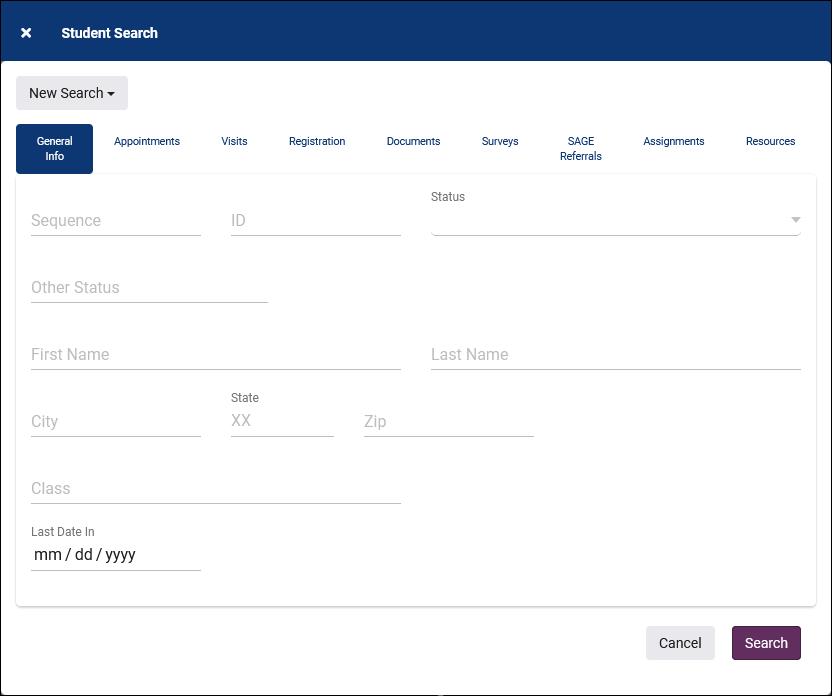
- Power Search
- This option provides a simple but powerful search utility to find the records you need. String together multiple searches, adding or removing results for each. Use Search Symbols to include ranges of data, and Save Searches for later use if needed. The search term 'blankornull' can be used to find all records with a value of nothing ("") or null ().

- Search by Term Enrollment
- Lists
- See Student Lists and Watch Lists for more information.
- See Student Lists and Watch Lists for more information.
- Saved Searches
- See Saved Searches for more information.
- See Saved Searches for more information.
- Find/Merge Duplicates
- These utilities can be used to cleanup duplicate records in your Trac System. We highly recommend reaching out to Redrock Support directly for assistance in cleaning up this data.
- These utilities can be used to cleanup duplicate records in your Trac System. We highly recommend reaching out to Redrock Support directly for assistance in cleaning up this data.
- Find by Values
- Change Field Values
- This utility allows you to make modifications in to your records in bulk. Similar to the Merge Duplicates utility, we highly recommend coordinating with Redrock Support directly on this setting.
- This utility allows you to make modifications in to your records in bulk. Similar to the Merge Duplicates utility, we highly recommend coordinating with Redrock Support directly on this setting.
- Selected...
- The Selection Tool offers several options to filter and manage your records. More information on this feature can be found in its own dedicated article here.
- The Selection Tool offers several options to filter and manage your records. More information on this feature can be found in its own dedicated article here.
- Views
- See Views for more information.
- See Views for more information.
- Send Survey
- Allows you to send a survey to the current user list. More information.
- Allows you to send a survey to the current user list. More information.
- Register In
- Allows you to quickly enroll a student in a new registration. Depending on your import configuration, manually recreated registrations may be deactivated during your auto-import.
- Allows you to quickly enroll a student in a new registration. Depending on your import configuration, manually recreated registrations may be deactivated during your auto-import.
- Assign Success Plan
- Allows you to assign a new Success Plan to the current student list. More information.
- Allows you to assign a new Success Plan to the current student list. More information.
- Create Referral
- Allows you to create a batch referral through SAGE. More information.
- Allows you to create a batch referral through SAGE. More information.
- Create Task
- Allows you to send a task to the current student list. More information.
- Allows you to send a task to the current student list. More information.
- Toggle Photos
- Enable or disable student photos on the Student Listing.
- Enable or disable student photos on the Student Listing.
- Create Chart
- Based on the data currently being viewed a chart can be generated to visually illustrate the relationships in the data.
- Based on the data currently being viewed a chart can be generated to visually illustrate the relationships in the data.
- Export CSV
- Export current listing contents to a CSV file.
- Export current listing contents to a CSV file.
- Send Email
- Allows you to send an email directly to a list of users.
- Allows you to send an email directly to a list of users.
- Send Email to Faculty
- This email utility allows you to email faculty linked to student registrations. The faculty recipients can be determined by subject, status, and grade. One email will be sent per linked registration, so if there are 3 students listed enrolled in MAT100 with Dave Smith, Dave Smith will receive 3 emails. Faculty recipients can also be filtered by scheduled day/time if section schedule is being imported.
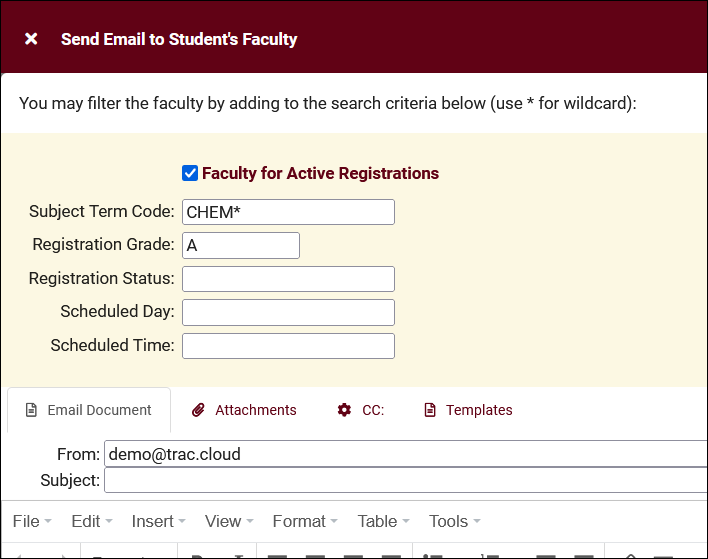
- Show these <records>
- This utility takes your selection of records, finds the related records, and takes you to that listing with the resulting records. For example, on the Registration listing, you can "Show these Students" to display the student records for the registrations that you were viewing.
- This utility takes your selection of records, finds the related records, and takes you to that listing with the resulting records. For example, on the Registration listing, you can "Show these Students" to display the student records for the registrations that you were viewing.
- Allows you to print the contents of the current listing, by extension this also allows you to export the current list as a PDF file.
- Allows you to print the contents of the current listing, by extension this also allows you to export the current list as a PDF file.
- New <Record>
- Allows you to create a new record based on your selected listing.
- Allows you to create a new record based on your selected listing.
See Also
Profile Preferences
Prefs
The Centers tab contains all of the Centers created in this profile. A center can represent a physical center, department, or any other division that you may want to designate. From this menu, we can also see the linked course list and the color designation.
Other > Other Options > Profiles > [Your Profile] > Centers
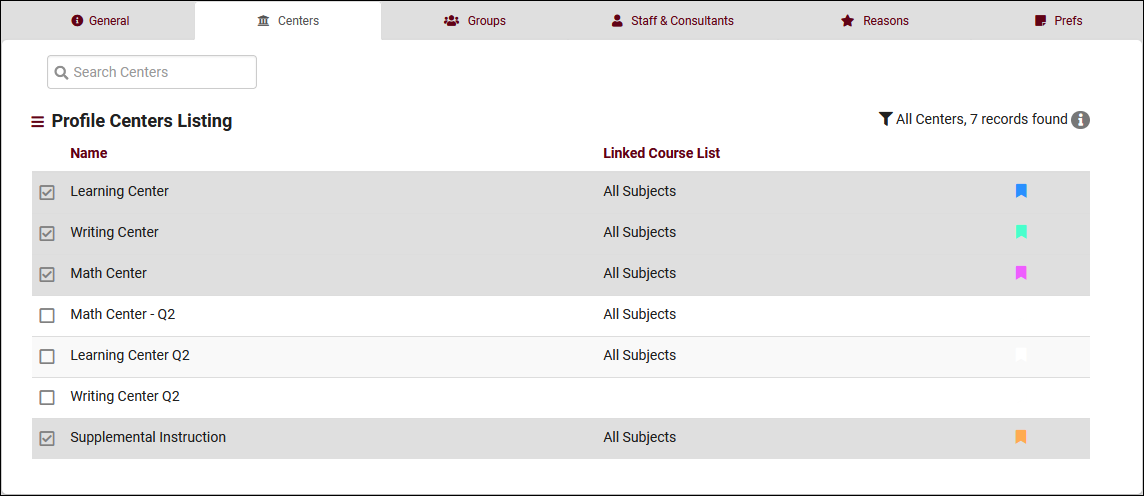
Creating a Center
The hamburger icon button contains the option to create a new center. Once selected, you will be taken to a General tab where you can start configuring your center.
- Inactive
- We never recommend deleting centers in TracCloud, as this will remove the related records (Visits/Appointments/etc) from reports and student/staff histories. Instead, we recommend setting these records to Inactive, which will hide it from view, but keeps the records available for reports or reactivation.
- We never recommend deleting centers in TracCloud, as this will remove the related records (Visits/Appointments/etc) from reports and student/staff histories. Instead, we recommend setting these records to Inactive, which will hide it from view, but keeps the records available for reports or reactivation.
- Profile
- All of your centers are assigned to profiles; this field displays which profile this particular center has been assigned to. This will default to whichever profile you started creating the center from.
- All of your centers are assigned to profiles; this field displays which profile this particular center has been assigned to. This will default to whichever profile you started creating the center from.
- Center Color
- Name
- The name of the center, which is typically displayed to all user types in regards to visit tracking and scheduling.
- The name of the center, which is typically displayed to all user types in regards to visit tracking and scheduling.
- Fund
- The optional fund or payment source for this center. Click here for more information on funds and payroll tracking.
- The optional fund or payment source for this center. Click here for more information on funds and payroll tracking.
- Ignore consultant specialties for this center (ie Writing Center)
- When searching for availabilities, only consultants who are assigned to the selected subject will appear. For example, when a staff member or student selects “MATH101”, only consultants who can assist with MATH101 will be displayed. This checkbox disables that, allowing consultants in this center to assist with any course, regardless of their assigned course list. This is typically used for writing centers, and only applies when searching for availabilities from the dashboard, and does not have an effect when booking appointments from the staff schedule. The center course list still applies as usual.
- When searching for availabilities, only consultants who are assigned to the selected subject will appear. For example, when a staff member or student selects “MATH101”, only consultants who can assist with MATH101 will be displayed. This checkbox disables that, allowing consultants in this center to assist with any course, regardless of their assigned course list. This is typically used for writing centers, and only applies when searching for availabilities from the dashboard, and does not have an effect when booking appointments from the staff schedule. The center course list still applies as usual.
- Maximum active visits in this center at one time
- By defining a limit in this field, you will prevent more than that number of students from logging into the center at once. When the limit is reached, login attempts will be met with the error "Too many students are currently active in this center. Please try again later." until a student logs out.
- By defining a limit in this field, you will prevent more than that number of students from logging into the center at once. When the limit is reached, login attempts will be met with the error "Too many students are currently active in this center. Please try again later." until a student logs out.
- Utilize Students/Consultant Link for this Center (if Defined in Profile)
- If configured in your profile options, students can be linked with advisors/consultants based on a field in their profile. When that student logs in, they will only see advisors that match their linked field. Checking this box enables this feature in this center. For example, students would only see advisors assigned to their major, etc.
- If configured in your profile options, students can be linked with advisors/consultants based on a field in their profile. When that student logs in, they will only see advisors that match their linked field. Checking this box enables this feature in this center. For example, students would only see advisors assigned to their major, etc.
- Students with Null or Blank Values in Linking field can book with anyone
- This option expands on the above, so that if a student does not have any data in their assigned advisor/major/etc field, they are allowed to see all consultants in search results. Otherwise, no results will be returned from this center.
- This option expands on the above, so that if a student does not have any data in their assigned advisor/major/etc field, they are allowed to see all consultants in search results. Otherwise, no results will be returned from this center.
- Hide on Log / KIOSK Listing Menu
- Enabling this option will remove this Center as a choice in the KIOSK and Log Listing menu, as well as from the available Center choices when logging into a Profile-wide Kiosk.
- Enabling this option will remove this Center as a choice in the KIOSK and Log Listing menu, as well as from the available Center choices when logging into a Profile-wide Kiosk.
- Hide for Work Visits on Consultant Work Login
- Enabling this option will remove this Center as a choice when staff members are logging in for work visits.
- Enabling this option will remove this Center as a choice when staff members are logging in for work visits.
- Course List for this Center
- This setting determines which courses are assigned and available in this center. Click here For more information on Course Lists in general.
- This setting determines which courses are assigned and available in this center. Click here For more information on Course Lists in general.
- Allow/Prevent Students
- Allow or block students on a specific list from logging into or booking appointments in this center. If a list is selected in an "allow" field, all other students would be automatically prevented from scheduling/logging in.
- Allow or block students on a specific list from logging into or booking appointments in this center. If a list is selected in an "allow" field, all other students would be automatically prevented from scheduling/logging in.
- Active Reasons Allowed for This Center
- The reasons assigned to this center. This controls which reasons are displayed when searching for and booking appointments, as well as the options available during kiosk logins.
Additional tab
The Additional tab contains information about the center that can be accessed from the Searching for Appointments screen. If preferred, a profile-wide default can be set rather than entering a unique description for every center. The center description takes priority if both are used.
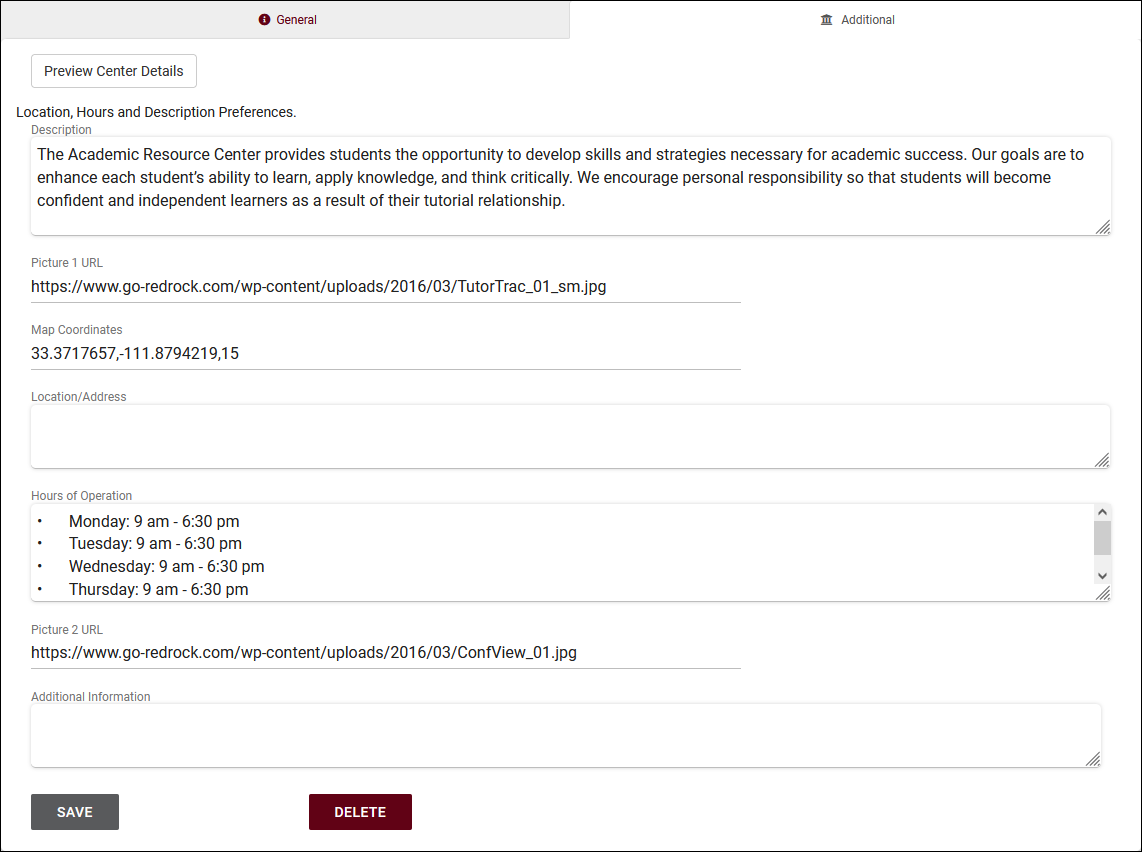
When searching for an appointment, you can click the info icon/center name, and the additional information will be displayed.
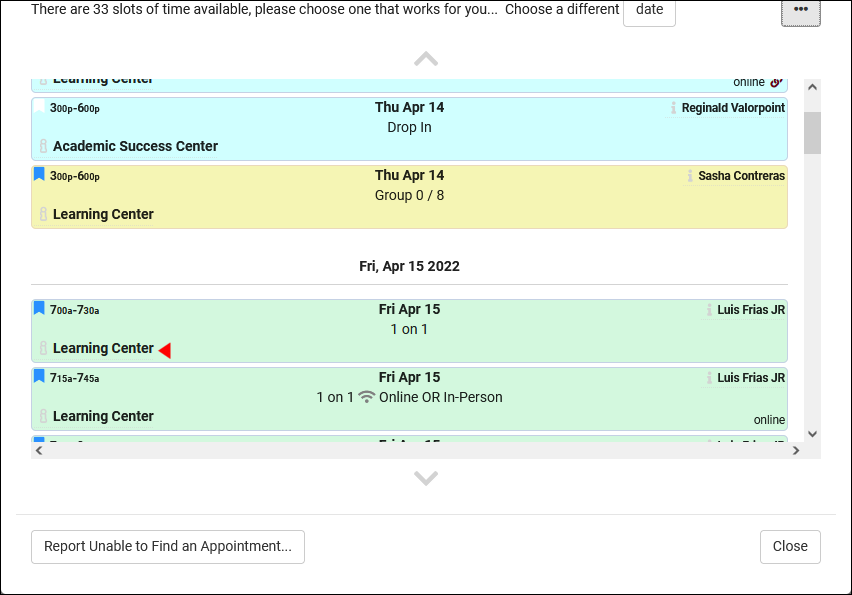
This information can contain a center description, map location, written location, additional info, hours of operation, and even photos. More information on configuring this screen can be found in our dedicated Locations, Hours, and Descriptions article.
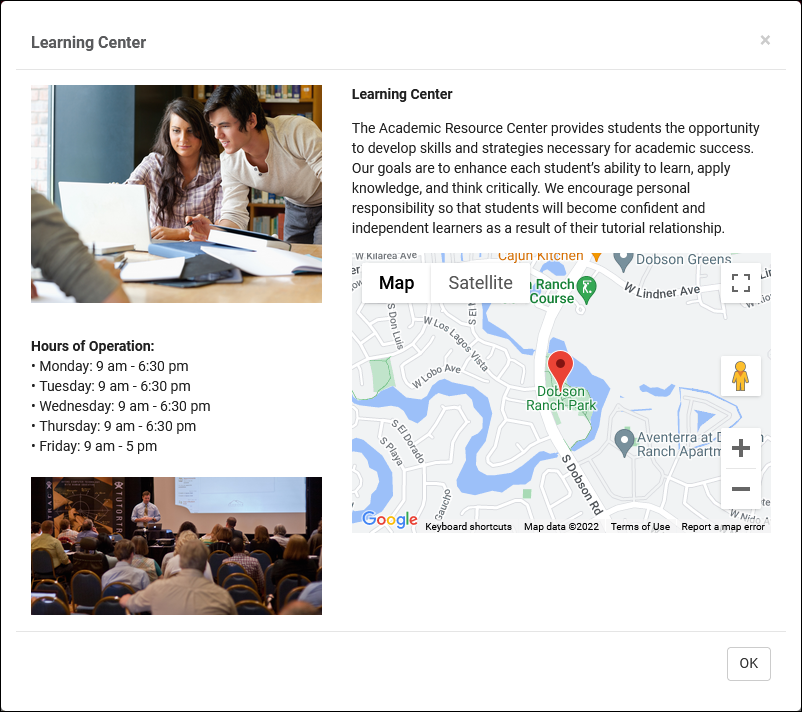
- Description
- This text field appears in the top-right corner of the Center Info window.
- This text field appears in the top-right corner of the Center Info window.
- Picture 1 URL
- A direct link to an image of your choice, this will appear in the top-left corner of Center Info.
- A direct link to an image of your choice, this will appear in the top-left corner of Center Info.
- Map Coordinates
- This will be the location displayed in the Google Maps box, and how far zoomed in/out the default view is. Formatted as Latitude, Longitude, default zoom level.
- For the default zoom, 12 would be fairly zoomed out, giving people a highway/main road reference, 15 would be a typical street-level view, and 18 would be a zoomed in campus-level view.
- Location/Address
- This will appear above the Google Maps box, providing the written address.
- This will appear above the Google Maps box, providing the written address.
- Hours of Operation
- Your center hours, displayed on the left-side of the Center Info box.
- Your center hours, displayed on the left-side of the Center Info box.
- Picture 2 URL
- A direct link to an image that will appear in the lower-left corner of the Center Info box.
- A direct link to an image that will appear in the lower-left corner of the Center Info box.
- Additional Information
- An additional text field that displays at the very bottom of the Center Info box.
- An additional text field that displays at the very bottom of the Center Info box.
Any field left blank will simply not appear in Center Info at all.
Profile Preferences
Prefs
This tab is where you will find your staff/consultants that have been assigned to this profile. From this view, we can see the staff names, the centers and group they’re assigned to, and what type of staff member they are (consultant or regular staff).
For a complete list of staff, not just staff assigned to this profile, go to Other > Other Options > Listings > Staff.
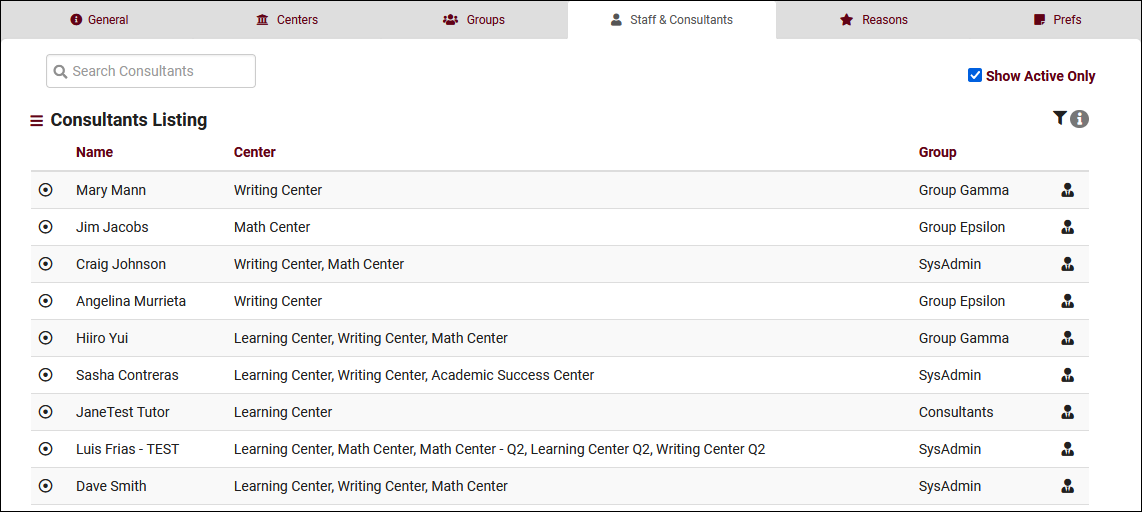
To create a new staff member, click on the hamburger button, then select “New Staff Member.”

- First Name, Last Name
- The staff member’s name. This will display on the staff schedule and in reports. This can also display to students if alias is not being used instead.
- The staff member’s name. This will display on the staff schedule and in reports. This can also display to students if alias is not being used instead.
- Username
- This is the username that this staff member will use to login (or for SSO authentication). Coordinate with your IT and/or Redrock Software to determine what your username format should be (e.g., ID number, email address, etc).
- This is the username that this staff member will use to login (or for SSO authentication). Coordinate with your IT and/or Redrock Software to determine what your username format should be (e.g., ID number, email address, etc).
- Other ID
- This is the alternate ID of this staff member, can be used for searches or staff work visits.
- This is the alternate ID of this staff member, can be used for searches or staff work visits.
- Hired / Terminated & Reason
- Hired/Termination dates as well as the reason for termination can be recorded for reference if needed. This does not affect Trac System functionality.
- Hired/Termination dates as well as the reason for termination can be recorded for reference if needed. This does not affect Trac System functionality.
- Staff Bio Confirmed & Confirmed Date / Time
- When and if this staff member has completed the confirm bio prompt. More information on Confirm Bio can be found here.
- When and if this staff member has completed the confirm bio prompt. More information on Confirm Bio can be found here.
- Pronouns
- This staff member's preferred pronouns, this information can be shared with students via Twig tags in emails or in Staff Bio on Search Availability.
- This staff member's preferred pronouns, this information can be shared with students via Twig tags in emails or in Staff Bio on Search Availability.
- Sort Code on KIOSK Login / Scheduler (A-Z)
- During visit login/logout or on the staff schedule, where a list of consultants are shown, the results will be sorted alphabetically by last name. You can enter text in this field to override this. For example, Hans Zimmer would typically be at the very end of the list, but if you enter "AAA" in this field, they would be displayed towards the very top instead. The opposite is also true, you can enter "ZZZ" for Dave Anderson to push him towards the bottom of the list.
- During visit login/logout or on the staff schedule, where a list of consultants are shown, the results will be sorted alphabetically by last name. You can enter text in this field to override this. For example, Hans Zimmer would typically be at the very end of the list, but if you enter "AAA" in this field, they would be displayed towards the very top instead. The opposite is also true, you can enter "ZZZ" for Dave Anderson to push him towards the bottom of the list.
- Staff BIO
- A written bio of this staff account. Can be displayed to students, more information.
- A written bio of this staff account. Can be displayed to students, more information.
- Inactive
- We don’t recommend deleting records in TracCloud, as this will also disconnect them from related records (Visits, Appointments, etc). Instead, we recommend deactivating the account by checking this box. This will hide them from view and prevent them from logging into TracCloud, but the record and related data remains available if needed, for historical reporting or later reactivation.
- We don’t recommend deleting records in TracCloud, as this will also disconnect them from related records (Visits, Appointments, etc). Instead, we recommend deactivating the account by checking this box. This will hide them from view and prevent them from logging into TracCloud, but the record and related data remains available if needed, for historical reporting or later reactivation.
- Title or Position
- This staff member's position title for reference if needed. This does not affect Trac System functionality.
- This staff member's position title for reference if needed. This does not affect Trac System functionality.
- Supervisor
- This person's assigned supervisor will be able to view their mentorship communications and asynchronous appointments from the dashboard.
- This person's assigned supervisor will be able to view their mentorship communications and asynchronous appointments from the dashboard.
- User Level
- The user level determines some baseline rules for what this staff member can and can’t access. More information.
- The user level determines some baseline rules for what this staff member can and can’t access. More information.
- Default Center
- This is the primary center the staff member is assigned to. Also determines which profile's "Staff & Consultants" list they appear in.
- This is the primary center the staff member is assigned to. Also determines which profile's "Staff & Consultants" list they appear in.
- Permission Group
- The permission group that this staff is assigned to. More information.
- The permission group that this staff is assigned to. More information.
- Linked Centers
- This is where you can assign staff members to different centers in TracCloud. A center must be assigned here for a consultant to have availabilities in or be assigned to visits for that center.
- This is where you can assign staff members to different centers in TracCloud. A center must be assigned here for a consultant to have availabilities in or be assigned to visits for that center.
- Notes
- An optional field for any notes that you may want to record relating to this staff member.
- An optional field for any notes that you may want to record relating to this staff member.
- Consultant
- • Alias
- An alternate name that will appear when searching for appointments. Requires the “Display consultant alias on availability search” option to be enabled in your Profile Scheduling Prefs.
- • Online Link
- If remote appointments are held via online conferencing platforms (Zoom, Webex, etc), each of your consultants can have a unique invite link defined in their profile. When a URL is placed here, and their availability is set the online meeting type, the URL entered in this field will appear in the available location choices.
- • Fund
- This is used as the consultant's assigned fund, if applicable. More information on funds and payroll features in general can be found here.
- • Pay Code
- This consultant’s pay code will determine their pay rate when running payroll reports. More information.
- • Max Hours
- Can be used to limit the number of hours this staff member can be booked in a certain range of days, even if they have open availabilities on their calendar. This requires setting up a corresponding max appointment rule, more information here.
- • Location
- The Location option assigned here will display as an option when creating availabilities on this consultant’s schedule.
- • Do not show on schedule
- If checked, this consultant will not show up on the schedule.
- • Course List of Specialties
- The course list selected here determines which subjects this consultant can assist with. More information on creating and managing course lists can be found here.
- • Accommodations
- These are the skills/accommodations that this consultant can assist with. For example, if accommodations are used to specify a preferred language, you could select the languages this consultant can assist with here. More information on configuring these accommodations can be found here.
- KIOSK
- If the “KIOSK” checkbox is selected, the account is heavily restricted and many fields are removed. Kiosk accounts can login and select a Kiosk to open, and nothing else. Normal staff members can open kiosks as well, but this can be useful if you need to create a generic account to share with other people to open kiosks in your center.
- If the “KIOSK” checkbox is selected, the account is heavily restricted and many fields are removed. Kiosk accounts can login and select a Kiosk to open, and nothing else. Normal staff members can open kiosks as well, but this can be useful if you need to create a generic account to share with other people to open kiosks in your center.
- Mentor
- Designates this staff account as a "Mentor" account. Click here to learn more about this feature.

Most of the options here are self-explanatory, just basic contact information about this staff member, such as their email address, phone number, address, etc. The icon indicates whether or not they're opted into text alerts. Custom fields can also be created on this page as well.

This menu allows you to view and manage this consultant’s certifications (e.g., CLRA, ACTP, etc). New certifications can be created by selecting the hamburger icon > New Certification, which will take you to an empty form to fill out. More information on Work Plans can be found in its own article by clicking here. You can additionally import certifications from the ACTP Tutor Trainer Tracker using the button at the bottom of the screenshot above.

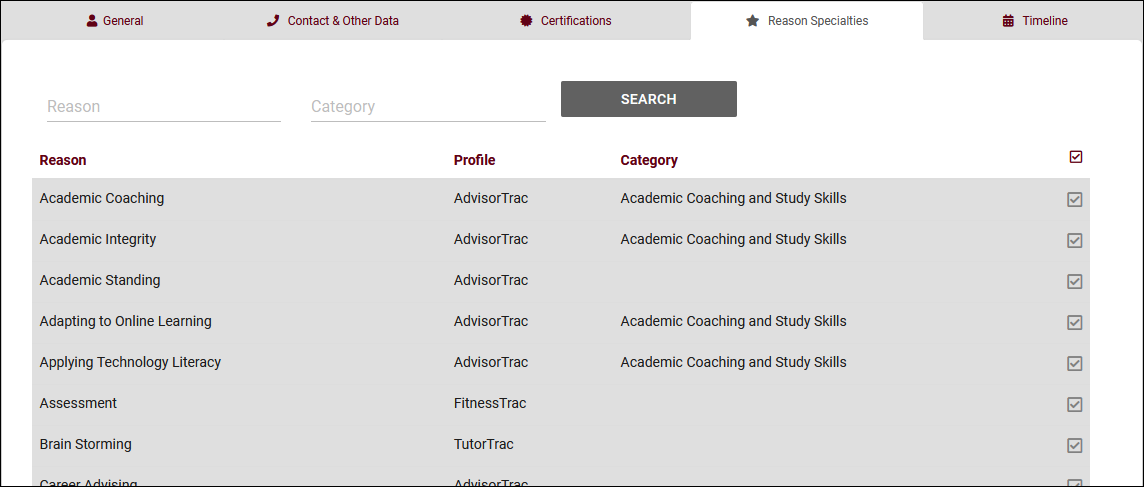
This tab allows you to specify which reasons this consultant is assigned to. If a user searches for availabilities with a reason that the consultant isn't assigned to, they won't appear in the search results, similar to section specialties.
The staff timeline operates similarly to the student timeline, showing a history of their related records. Visits, appointments, tasks, document uploads, etc.
To view a list of all staff accounts in TracCloud across multiple profiles, go to Other > Listings Staff.
Staff records can be duplicated by clicking the button. This will copy group, user level, default center, linked centers, consultant status, course list (generic course lists only, per-consultant course lists will not be copied), reason specialties, and accommodations to a new staff record and prompt you to replace unique information such as name, address, etc.
Hamburger Menu
Every listing page in the Trac System features a hamburger menu with utilities to search for or interact with your list of records. Some of these options are specific to a certain listing/record-type, others are shared. The following list includes definitions for the hamburger menu options available on this listing, and how they can be utilized.
- List All
- This option will show all records on the current listing. Some listings have an additional toggle for only showing "Active" records, such as Students and Registrations, which will still override a "List All" search if checked.
- This option will show all records on the current listing. Some listings have an additional toggle for only showing "Active" records, such as Students and Registrations, which will still override a "List All" search if checked.
- Power Search
- This option provides a simple but powerful search utility to find the records you need. String together multiple searches, adding or removing results for each. Use Search Symbols to include ranges of data, and Save Searches for later use if needed. The search term 'blankornull' can be used to find all records with a value of nothing ("") or null ().

- Saved Searches
- See Saved Searches for more information.
- See Saved Searches for more information.
- Selected...
- The Selection Tool offers several options to filter and manage your records. More information on this feature can be found in its own dedicated article here.
- The Selection Tool offers several options to filter and manage your records. More information on this feature can be found in its own dedicated article here.
- Change Field Values
- This utility allows you to make modifications in to your records in bulk. Similar to the Merge Duplicates utility, we highly recommend coordinating with Redrock Support directly on this setting.
- This utility allows you to make modifications in to your records in bulk. Similar to the Merge Duplicates utility, we highly recommend coordinating with Redrock Support directly on this setting.
- Views
- See Views for more information.
- See Views for more information.
- Batch Create Certifications/Work Visits & Batch Activate/Deactivate
- Allows you to create these Staff-specific records in bulk, or change the activation status of many staff members at once.
- Allows you to create these Staff-specific records in bulk, or change the activation status of many staff members at once.
- Export CSV
- Export current listing contents to a CSV file.
- Export current listing contents to a CSV file.
- Send Email
- Allows you to send an email directly to a list of users.
- Allows you to send an email directly to a list of users.
- Allows you to print the contents of the current listing, by extension this also allows you to export the current list as a PDF file.
- Allows you to print the contents of the current listing, by extension this also allows you to export the current list as a PDF file.
- Create Task
- Allows you to send a task to the current student list. More information.
- Allows you to send a task to the current student list. More information.
- New <Record>
- Allows you to create a new record based on your selected listing.
- Allows you to create a new record based on your selected listing.

